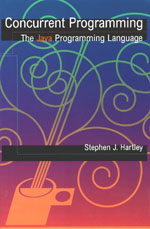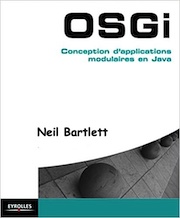
|
FreeComputerBooks.com
Links to Free Computer, Mathematics, Technical Books all over the World
|
|
- Title: Concurrent Programming: The Java Programming Language
- Author(s) Stephen J. Hartley
- Publisher: Oxford University Press, USA (March 26, 1998)
- Paperback: 272 pages
- eBook: HTML and PDF
- Language: English
- ISBN-10: 0195113152
- ISBN-13: 978-0195113150
- Share This:

|
The popularity of the Internet has led to rapidly expanding interest in client-server programming by all kinds of businesses and organizations. Many client and server applications benefit from their design as object-oriented programs with multiple threads of control. An object-oriented language with built-in threads, Java is ideal for concurrent programming and developing multi-threaded applications.
Demand for programmers skilled in object-oriented design and concurrency will only grow in the future, making concurrent programming and the Java programming language increasingly important to programming students and professionals.
Designed for students and professionals, Concurrent Programming: The Java Programming Language provides a practical, demonstrative introduction to the issues and concepts in concurrent programming, operating systems, the client-server model, and multiple threads. It features numerous Java example programs as stand-alone applications rather than as simple applets, showing readers how to utilize the Java programming language to write programs that use semaphores, monitors, message passing, remote procedure calls, and the rendezvous for thread synchronization and communication.
Each example program includes output from one or more sample runs. Multithreading issues such as race conditions, critical sections, mutual exclusion, and condition synchronization are covered. Several thread communication tools used extensively in client server programming - message passing, the rendezvous, and remote procedure calls - are also described. An algorithm animation package, written in Java, is used in several of the example programs.
The book concludes with a brief introduction to parallel processing with Java.
About the Authors- N/A

- Concurrent Programming: The Java Programming Language (Stephen J. Hartley)
- The Mirror Site (1) - PDF
- The Book Homepage
-
 The Little Book of Semaphores: Concurrency Control
The Little Book of Semaphores: Concurrency Control
This book introduces the principles of synchronization for concurrent programming. The approach of this book is to identify patterns that are useful for a variety of synchronization problems and then show how they can be assembled into solutions.
-
 Parallel and Concurrent Programming in Haskell
Parallel and Concurrent Programming in Haskell
This hands-on book shows you how to use the language’s many APIs and frameworks for writing both parallel and concurrent programs. You'll learn how parallelism exploits multicore processors to speed up computation-heavy programs.
-
 Concurrent Programming in Erlang, 2nd Edition (J. Armstrong, et al)
Concurrent Programming in Erlang, 2nd Edition (J. Armstrong, et al)
This book employs a tutorial approach to guide the reader through the programming of real-time and distributed fault-tolerant systems.
-
 Dynamic Proxies in Java (Heinz M. Kabutz)
Dynamic Proxies in Java (Heinz M. Kabutz)
Dynamic proxies are such a tool that we can use it to save thousands of lines of repetitive code with a single class. This book is for intermediate to advanced Java programmers who want to get to "guru" status. It is not suitable for beginners in Java.
-
 The Java Web Scraping Handbook (Kevin Sahin)
The Java Web Scraping Handbook (Kevin Sahin)
This book will teach you how to extract data from any website, how to deal with AJAX / Javascript heavy websites, break captchas, deploy your scrapers in the cloud and many other advanced techniques, using Java programming language.
-
 Naked Objects (Richard Pawson, et al)
Naked Objects (Richard Pawson, et al)
The aim of this book is to introduce you to the concept of designing business systems from naked objects, and to enable you to start building such systems using the Naked Objects framework. It outlines a lightweight methodology and provides a short tutorial.
-
 Java Transaction Design Strategies (Mark Richards)
Java Transaction Design Strategies (Mark Richards)
This book is about how to design an effective transaction management strategy using the transaction models provided by Java-based frameworks such as EJB and Spring. Techniques, best practices, and pitfalls with each transaction model will be described.
-
 Playing with Java Microservices on Kubernetes and OpenShift
Playing with Java Microservices on Kubernetes and OpenShift
This book is written for Java developers who wants to build microservices using the Spring Boot/Cloud stack and who wants to deploy them to Kubernetes and OpenShift. Teach you how to build and design microservices using Java and the Spring platform.
-
 Object-Oriented vs. Functional Programming (R. Warburton)
Object-Oriented vs. Functional Programming (R. Warburton)
This book discusses similarities between these programming paradigms and points out that both FP and OOP are actually moving closer toward one another. One prominent example is the use of lambda expressions in Java and other OOP languages.
-
 High-Performance Java Platform Computing
High-Performance Java Platform Computing
Threading and concurrency are crucial to building high-performance Java applications. This book thoroughly demystifies them, helping developers leverage threading and concurrency to solve a wide variety of performance problems.
-
 Docker for Java Developers (Arun Gupta)
Docker for Java Developers (Arun Gupta)
This book introduces basic Docker concepts and explains how to achieve faster startup and deployment of your Java‑based applications, shows how Docker containers can save you many headaches when it comes to packaging, deploying, and scaling your applications.
-
 OSGi In Practice (Neil Bartlett)
OSGi In Practice (Neil Bartlett)
This book is a comprehensive guide to OSGi with two primary goals: first introducing to OSGi concepts with examples, then exploresing numerous practical scenarios and techniques, as well as answering questions.
-
 TCP/IP Sockets in Java, 2nd Ed: Practical Guide for Programmers
TCP/IP Sockets in Java, 2nd Ed: Practical Guide for Programmers
This book's focused, tutorial-based approach helps the reader master the tasks and techniques essential to virtually all client-server projects using sockets in Java. It also covers several new classes and capabilities in the last few revisions of the Java.
-
 Building Reactive Microservices in Java (Clement Escoffier)
Building Reactive Microservices in Java (Clement Escoffier)
This book is for developers and architects interested in developing microservices and distributed applications. It does not explain the basics of distributed systems, but instead focuses on the reactive benefits to build efficient microservice systems.
-
 Microservices for Java Developers: Frameworks and Containers
Microservices for Java Developers: Frameworks and Containers
In this hands-on, example-driven guide, Java developers and architects will learn how to navigate popular application frameworks, such as Dropwizard and Spring Boot, and how to deploy and manage microservices at scale with Linux containers.





